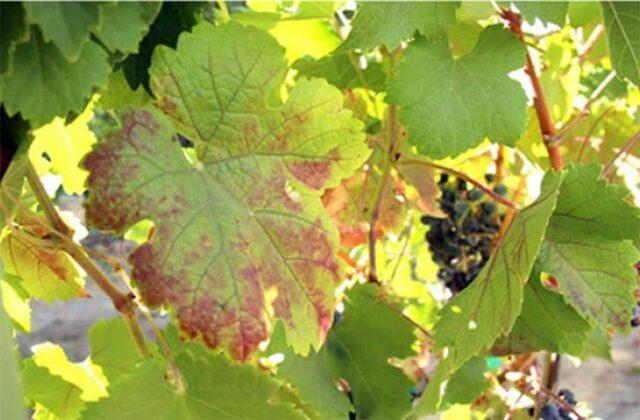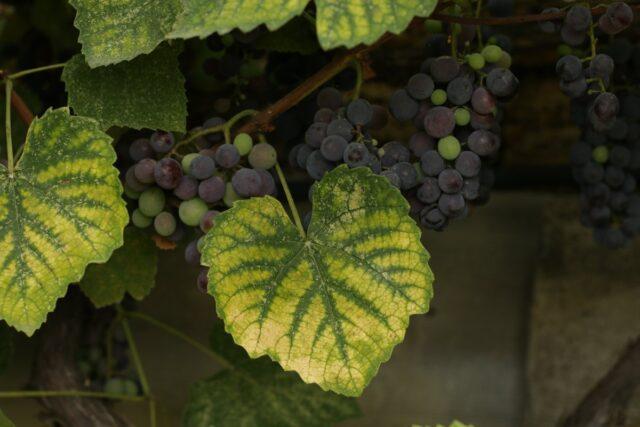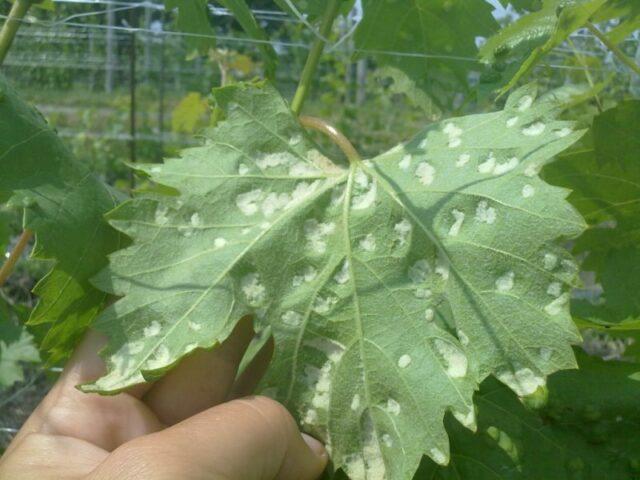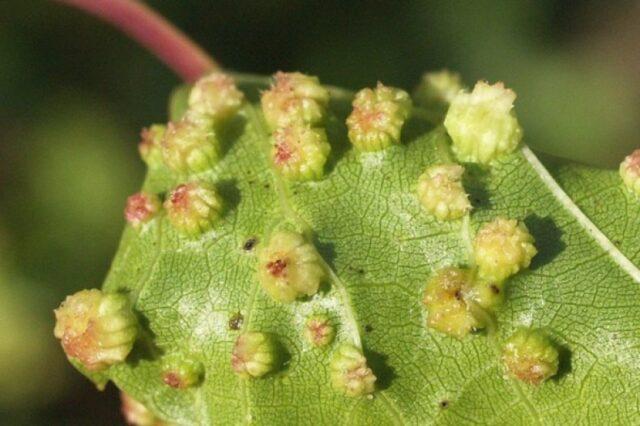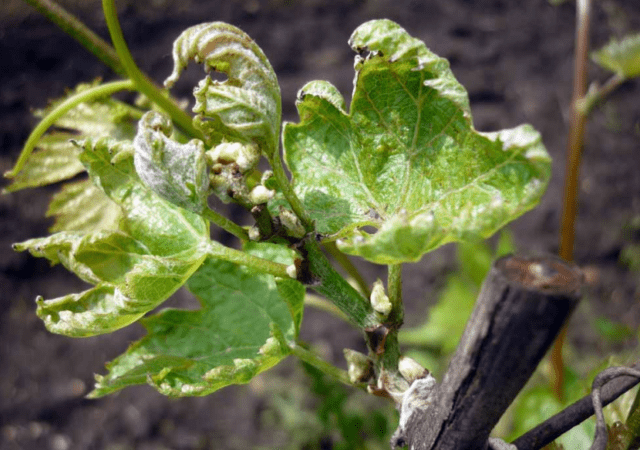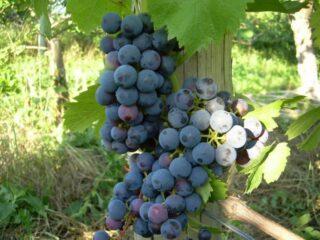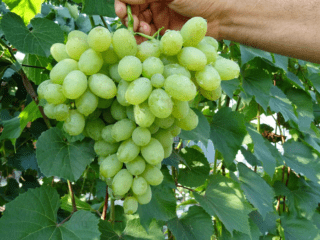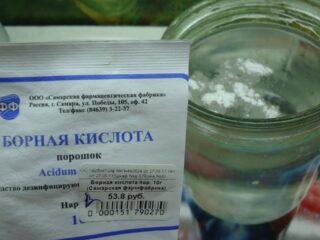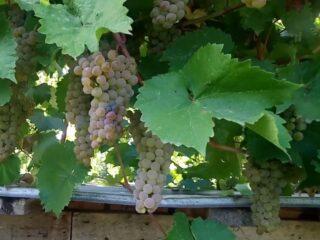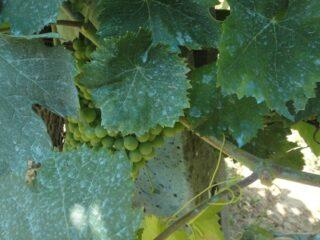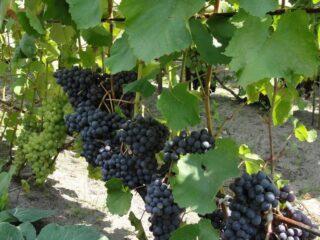Content
Brown spots on grape leaves can be associated not only with diseases, but also with improper care. Even if the cultivation technology is correct, the weather may fail. Grapes are a heat-loving crop and can suffer from cold, late springs and rainy summers.
Why are there dark spots on grape leaves?
If foliage, shoots and other parts of the grapes become covered with brown spots, this may be due to various reasons. They can be divided into several groups:
- deficiency or excess of individual microelements;
- excessive watering;
- fungal diseases;
- bacterial pathologies;
- viral infections;
- objective factor - temperature changes, cold spring, rainy summer.
Determining the cause is not always easy.Brown spots can appear due to several factors at once. Therefore, for prevention, it is necessary to immediately adjust watering and apply complex fertilizing.
Non-infectious causes
The appearance of rusty spots on grape leaves does not always indicate infectious diseases. Often the problem is due to improper care, damage or weather conditions.
Weather or damage
Brown spots on grape leaves and vines may appear due to unfavorable weather. Almost all grape varieties require warmth and plenty of light. They do not tolerate temperature changes, cool and rainy summers. Therefore, varieties must be selected in accordance with the climatic characteristics of the region. If the weather often turns bad, it is better to grow bushes in a greenhouse.
Also, brown spots on leaves and shoots appear due to mechanical damage, for example, due to strong wind. Therefore, when growing, it is recommended to put up supports, which is especially important for young seedlings.
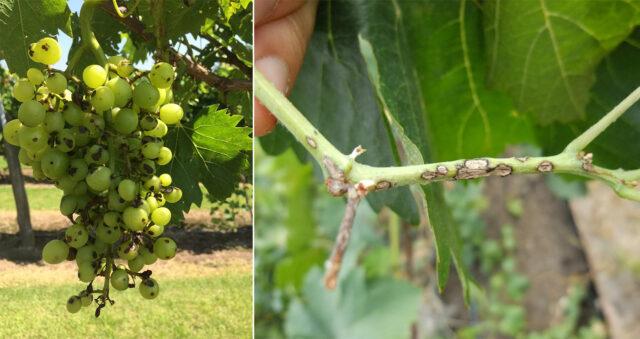
Brown spots often affect not only leaves, but also grape shoots
If there are diseases, the bushes will be clearly underdeveloped. Outwardly, this manifests itself by the following signs:
- short shoots;
- asymmetrical shape - growth is more pronounced in one direction than in the other;
- the stains will spread more actively and begin to rot quickly.
Improper care
Improper care can cause brown spots that look like rust to appear on grape leaves. This is due to the following factors:
- excessive or insufficient watering;
- frequent application of fertilizers or lack thereof;
- lack of sunlight due to improper planting location (shade).
The foliage begins to fade or turn pale, loses its elasticity over time, and becomes covered with dots.
Micronutrient deficiency
Brown spots on grape leaves can also appear as a result of a lack of certain microelements:
- With potassium deficiency, the leaves first turn yellow. After which a brown color appears along the contour of the leaves. Moreover, the affected areas become very fragile. When the potassium deficiency becomes too great, very dark, almost black spots will appear on the foliage. After this, there will be holes instead.
- If there is little calcium supply, the foliage becomes lighter. Moreover, over time, rusty or brown spots appear on the grape leaves. Gradually they begin to curl and fade, and then fall off.
- Iron deficiency results in yellow areas that darken and become brownish over time.
Fungal infections
Dark spots on grape leaves, vines and fruits are very often associated with fungal diseases. This is a particularly dangerous situation because the disease spreads quickly and the spores are transmitted through the air to other plants. Therefore, it is advisable to recognize the infection and carry out treatment as early as possible.
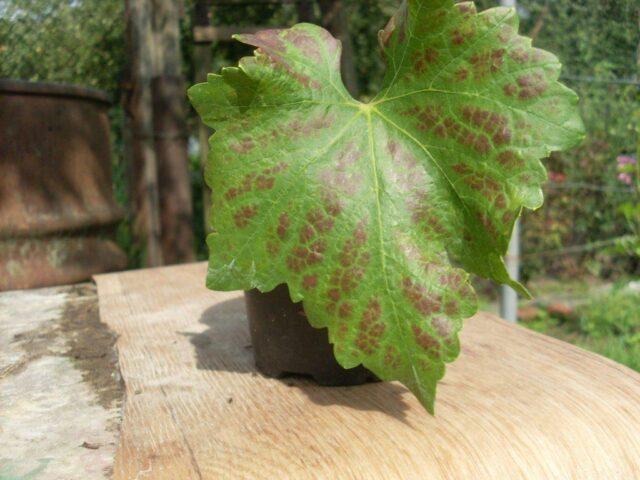
The massive appearance of brown spots indicates the development of fungal infections
Mildew
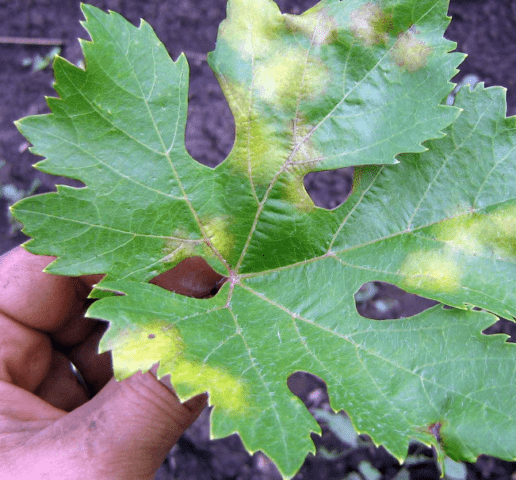
Mildew is a common pathology, also called downy mildew.
It is quite easy to detect – the disease manifests itself with the following symptoms:
- brown, with a red or yellowish tint, areas on the upper side of the leaf blade;
- drying out, darkening and death of foliage;
- thick white coating on inflorescences and berries;
- dark spots not only on the leaves, but also on the grape vine, and the shoots gradually dry out and die.
Anthracnose
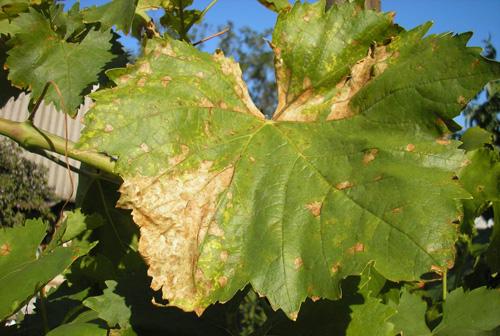
Anthracnose affects all above-ground plant organs
In Russia, this disease occurs infrequently - it is mainly common in countries with warm climates, including Central Asia, Ukraine, Moldova, and Transcaucasia. Main features:
- Brown spots with a whitish border form on the leaves. Over time they begin to merge;
- damaged tissues die and fall out;
- depressed brown dots form on the shoots;
- branches become dry and break;
- Dark spots also form on grapes over time.
Oidium
This infectious fungal disease is also called powdery mildew. The main symptoms of the lesion are:
- grayish-white dust on foliage;
- leaf blades lag behind in development and become curly;
- inflorescences and clusters seem to be sprinkled with flour or ash;
- the berries begin to dry out, peas are observed;
- Gradually, mold develops on the fruits, which only accelerates their death.
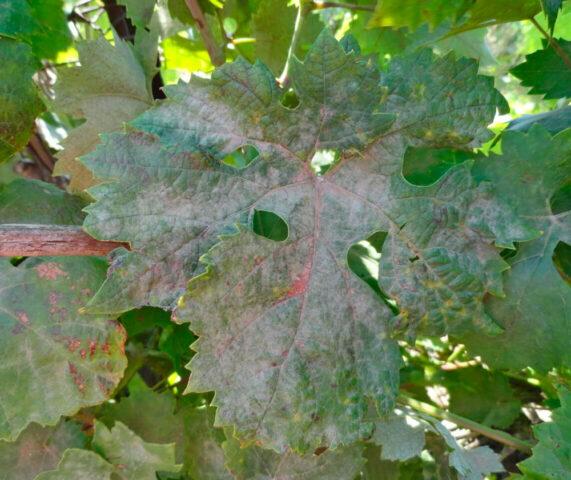
Mildew affects not only foliage, but also berries
Black spot (escoriosis)
This infection develops on different parts of the grapes. Visually, pathology can be determined by the following signs:
- the bark becomes discolored;
- fruiting bodies of fungi form on the affected areas;
- the dots enlarge and merge, becoming longitudinal brown spots;
- Necrotic areas of dark, almost black shades appear on the foliage, which gives the disease its name.

A grape leaf blade affected by black spot can be easily seen upon visual inspection.
Cercospora
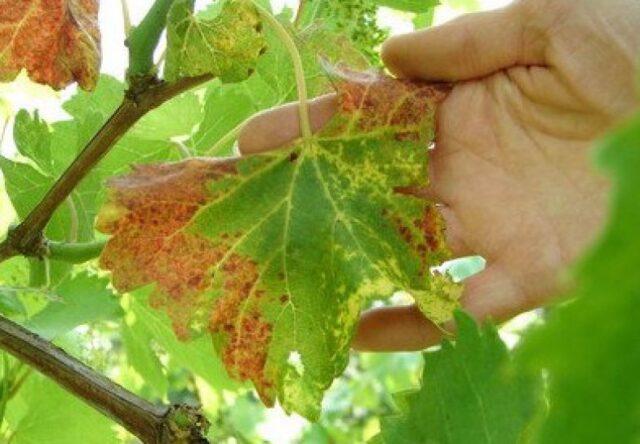
Cercospora can be detected at an early stage
When the disease occurs, olive-colored spots form on the underside of grape leaves. Over time, they darken and become brown, while their outline is light.
Fusarium
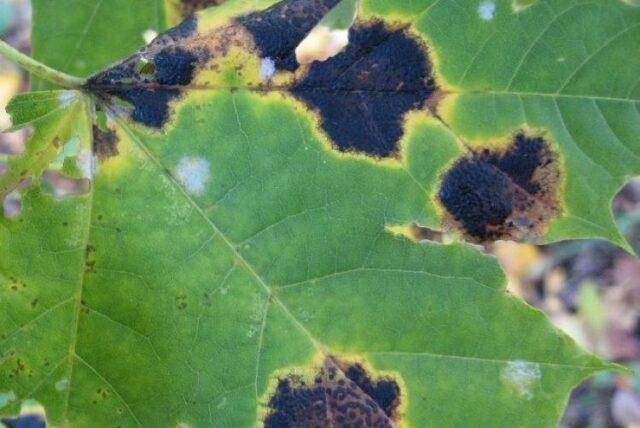
Fusarium is accompanied by a sharp yellowing of almost all grape leaves
Yellowish spots are visible on shoots and berries. Then they turn brown, after which the foliage dries out and dies.
Alternaria blight
Another dangerous fungal disease that leads to the appearance of brown spots on the foliage, less often with a silver tint.
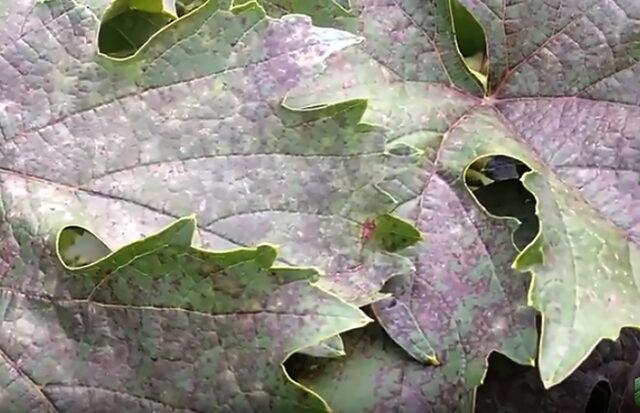
The peculiarity of Alternaria is its very rapid spread.
Grape plantings should be periodically inspected so that, if necessary, treatment can be carried out immediately.
Bacterial infections
The appearance of rusty spots on leaves can also be associated with bacterial diseases. They are also infectious in nature, so there is a danger of infecting several plants.
Bacterial cancer
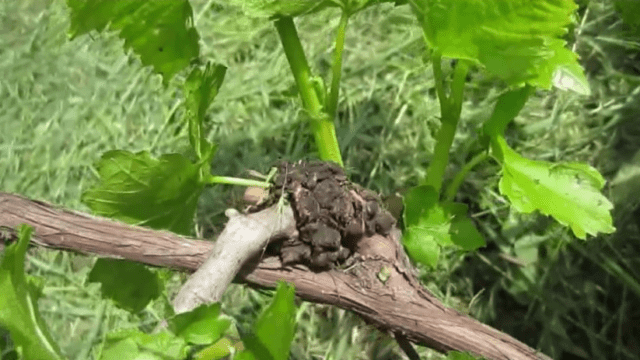
Cancer affects different parts of the vine, often in the lower area, close to the soil surface, less often the roots
Visually, the disease is a white or brown fleshy tumor. Cancer is clearly visible only in the middle of the season, in July-August. As the tumor develops, it quickly increases in size, its diameter reaches several centimeters, sometimes 10-15 cm.
Bacteriosis
Bacteriosis (also Pierce's disease) affects the entire plant or only individual parts. It is associated with pathogenic bacteria that are spread by insect vectors. The main symptoms are irregularly shaped greenish and brown spots. They mainly appear on shoots.

With bacteriosis, plants lag behind in growth, wither and die
Bacterial necrosis
This disease is also called bacterial wilt or Oleuron's disease. It affects all organs of grapes - brown spots appear on leaves, shoots and berries. Black cankers form on perennial branches; they are deeply pressed in, causing the surface to become embossed. The shoots become fragile, quickly break and die.
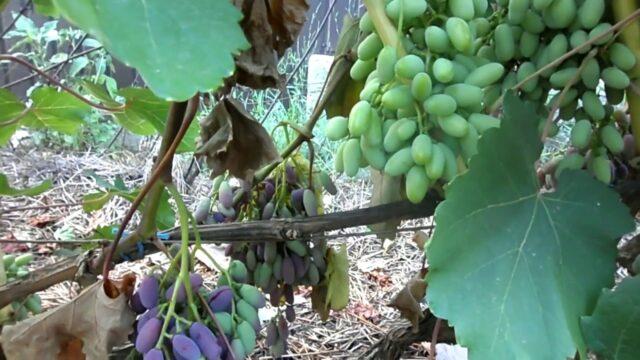
Brown speckles may be a sign of bacterial necrosis
Viral infections
The appearance of rusty, brown spots on grape leaves is sometimes associated with viral diseases. The most common infections are:
- Red spot virus causes damage to foliage. Areas of a brownish-red hue appear on the surface; over time, they may turn brownish. Leaves curl and die.
- Necrosis of the veins leads to inhibition of growth and the appearance of a dark brown bark; black dots and cracks running along the shoot are often noticeable on it.
Pests
Insects are another group of reasons due to which brown spots appear on the leaves and shoots of grapes. Pests dangerous to grapes:
- The most common are ticks. The main symptom is tubercles on the leaf blade, covered with a thin cobweb. The tick is dangerous not only in itself, but also because it carries fungal infections, which can lead to loss of yield and even death of the bush.
- Grape aphid (phylloxera) - its invasion can be recognized by the appearance of galls on the foliage, and they are not noticeable immediately, but only in the second year.Over time, the damaged areas become covered with brown bumps and swellings. At the same time, the pest itself is not noticeable, since the aphid spends most of its time in the root zone of the bush.
- Thrips lead to the formation of brown spots on grape leaves, causing them to lose their shape and gradually curl. This has a bad effect on all parts of the plant.
What to do if grape leaves are covered with brown spots
First of all, it is necessary to diagnose the cause. If this cannot be done, you need to adjust the watering and feed the plant with organic matter or a complex mineral composition. The supplement should contain various microelements, including calcium and iron.
If these measures helped, then the grapes did not suffer from infection. But if the care is normal, and the weather is good enough, and the brown spots do not go away, the cause is most likely related to diseases. In this case, it is necessary to carry out 1-2 treatments with special preparations:
- "Horus";
- "Strobe";
- "Topaz";
- "Thanos";
- "Tiovit";
- "Fitoverm";
- "Arcedrid";
- "HOME."
They are effective in fighting fungi. In the case of bacterial and viral damage, it is not always possible to achieve results. If the bush is badly damaged and covered with brown spots, it is better to plant it in a quarantine zone or immediately burn it.
Insecticides are used to control pests:
- "Karate";
- "Talstar";
- "Aktellik";
- "Inta-Vir";
- "Kinmiks" and others.

For prevention, grapes should be processed every spring.
Preventive actions
As a preventive measure, it is recommended to follow basic care measures:
- do not overuse watering - give water once every 1-2 weeks (the surface layer of soil should have time to dry out);
- regularly apply fertilizer at least twice a season;
- carry out preventive treatments in mid-spring;
- when growing in a greenhouse, ventilate it periodically;
- When planning plantings, do not make them too dense - there should be a gap of at least 80-100 cm between the crowns.
Conclusion
Brown spots on grape leaves are not the norm - their appearance always indicates improper care, bad weather, or the development of diseases. Therefore, it is recommended to regularly inspect the plantings and, if necessary, take immediate action: feed the plant, treat with medications. During the fruiting period, it is better to use folk remedies.
